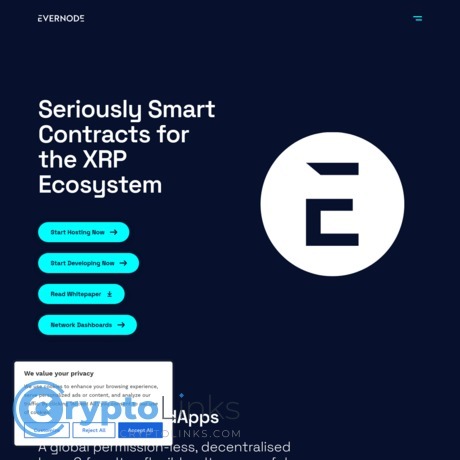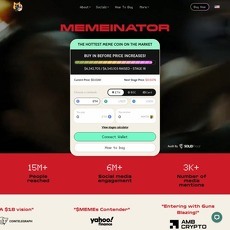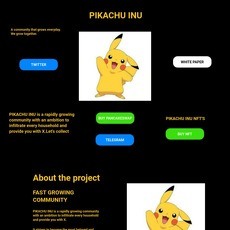Evernode Review
Evernode
evernode.org
If your website is on the scam list and you think that you are not a scammer, contact us. After you provide us with all the proof that you are in Crypto World with good intentions, we will delist you. Usually, you get in this category because you are hiding your team, you have a bad reputation(you are tricking, deceiving, scamming people), and you haven't got a written project whitepaper or is a shitty one....
Their Official site text:
© Evernode Labs Pty Ltd 2023
Seriously smart contracts for the XRPL Ecosystem
by
Evernode Labs Pty Ltd
20 Nov 2023
(updated 12 January 2024)
Whitepaper 2.0
Page | 2 © Evernode Labs Pty Ltd 2023
Table of Contents
1. EXECUTIVE SUMMARY 4
Evernode’s Five Components 4
Hosts 4
Developers 4
Initiator 4
Proposed Launch 4
2. HOTPOCKET – CONSENSUS-AS-AN-OPERATING-SYSTEM 5
UNL Consensus Protocol 5
Rapid State Syncing 6
Contract Config Sync 7
3. SASHIMONO – DECENTRALISED HOSTING 7
Anatomy Of A DApp Instance 7
State Filesystem 8
HotPocket vs dApp 8
Multi-Tenant Instance/Container Management 9
Sashimono – Container Daemon Separation 9
Multi-Tenant Separation 10
4. XAHAU REGISTRY HOOK - DECENTRALISED NETWORK 11
The Xahau Network & Hooks 11
Making Evernode Decentralised with Xahau Hooks 12
Ensuring Quality Hosts 12
Why Not Be a “Layer 1” Network? 13
Why Choose the Xahau Network? 13
Why Not the XRP Ledger? 14
5. EVERS - EVERNODE’S NATIVE DIGITAL CURRENCY 15
Holding Evers 15
Using Evers 15
Acquiring Evers 15
Why Have a Native Currency? 16
Why Not Use XRP or XAH? 16
6. EVERNODE’S ON-CHAIN GOVERNANCE GAME 17
Participants 17
Types of Proposals 17
Withdrawing a Proposal 18
Purging a Proposal 18
Voting 18
Page | 3 © Evernode Labs Pty Ltd 2023
Electing a Proposal 18
Evernode Labs Special Rights 18
Governance Mode – 3 Levels of Decentralisation 18
7. ANYONE CAN BE A GOOD HOST & EARN EVERS 19
Being a Good Evernode Host 20
Hosting Rewards – Incentivising Hosts to Exist 20
Hosting Fees – Paying Hosts for Hosting 21
8. ANYONE CAN BE AN EVERNODE DAPP DEVELOPER 21
Benefits of Evernode dApps 21
Sample Use Cases 22
9. INITIATOR - EVERNODE LABS PTY LTD 22
10. PROPOSED LAUNCH 23
Page | 4 © Evernode Labs Pty Ltd 2023
1. EXECUTIVE SUMMARY
1.1 Evernode is a global, permissionless, decentralised “layer 2” network tailored to
hosting hyper-flexible, hyper-scalable dApps that perform as bespoke miniblockchains (“AppChains”), empowering developers to build with their choice
of language, functionality, geography, and scale, but without needing to
invent their own consensus mechanism.
Evernode’s Five Components
1.2 Evernode has five main components:
(a) Consensus: A consensus-as-an-operating-system environment in which
code runs to enable multiple instances to function as a bespoke chain.
(b) Hosting: A way to deploy multiple instances of an executable program to
a global network of independently owned and operated hosts.
(c) Decentralised Network: A way of coordinating the network via a layer 1
chain so the network is as secure and decentralised as possible.
(d) Native Token: A new digital asset for the network to incentivise hosts and
facilitate automated payment for network registration and hosting fees.
(e) Decentralised Governance: A way for hosts to vote to update the rules for
registration, rewards, and governance, including deregistering bad hosts.
Hosts
1.3 In concert, these five components create a decentralised network where
anybody can become a Host by downloading the Evernode software and
paying the registration fee in Evers. Reliable hosts earn network rewards for
being connected to the network and earn income in the network’s currency
from hosting dApps.
Developers
1.4 For Developers, these five components result in a global network of
independently owned and operated Hosts on which they can build and deploy
dApps with their choice of language, behaviours, geography, and scale. In
conjunction with Hooks, Xahau’s lite smart contract solution, a vast new range
of use cases for decentralised applications arises.
Initiator
1.5 Evernode is an initiative of Evernode Labs Pty Ltd, a private Australian company
spun out of the Australian National University to commercialise IP arising from
research funded by grants from Ripple’s University Blockchain Research
Initiative.
Proposed Launch
1.6 Evernode plans to launch fully functional on 18th December, or as soon as
possible thereafter, depending on the existence of a wallet that fully supports
the Xahau Network and its XRPL account-cloning feature.
Page | 5 © Evernode Labs Pty Ltd 2023
2. HOTPOCKET – CONSENSUS-AS-AN-OPERATING-SYSTEM
2.1 The inspiration for Evernode was this: the XRP Ledger is a payment App inside a
consensus engine, so what if you could take the payment App out and insert
any other type of App as desired into the consensus engine? Thus, was born the
consensus engine we call HotPocket.
2.2 HotPocket uses a cooperative UNL-based consensus algorithm akin to the
Ripple Consensus Protocol, abstracted for any transaction or input type. It
transforms standard Apps into dApps.
2.3 We call them dApps, but really, they are bespoke mini-blockchains (or
“AppChains”) that behave as the developer wants. Its UNL, the files it reads and
writes, its inputs and outputs etc are all subject to consensus within the dApp’s
UNL. HotPocket provides all this as a sort of “consensus-as-an-operating-system”
solution as summarised in Figure 1 below.
Figure 1: Evolution of a HotPocket Cluster
2.4 HotPocket has four main components:
(a) UNL Consensus Protocol: HotPocket is a Unique Node List (UNL) based
consensus protocol that allows multiple Linux machines to become a
mini-blockchain by enforcing consensus rules on inputs and outputs and
maintaining a shared, canonical state across multiple instances.
(b) Rapid State Sync: HotPocket contains a bundle of additional features
designed to make it as easy as possible to spin up a HotPocket node and
sync it to the existing network.
(c) Contract Lifecycle Management: HotPocket ensures all instances of a
contract have the same configuration and allows contracts to be
upgraded automatically at consensus.
(d) Minimal Setup: HotPocket enables new nodes to join an existing contract
with minimal known information to sync the new node with the cluster.
UNL Consensus Protocol
2.5 The HotPocket consensus engine works as follows:
(a) Set Up: The programmer configures a set of servers and builds a Unique
Node List of these servers’ public keys and a peer list of IPs and ports. This
configuration is copied to all servers in the contract’s network.
(b) Synchronisation: During execution, each HotPocket instance connects to
its peers and synchronizes the current contract state across all UNL peers
according to a configurable consensus threshold of between 50% and
100% of nodes, depending on the desired trade-off between liveness and
security. Once state transfer and synchronization are achieved, the
contract’s network collects inputs from the contract’s users.
Page | 6 © Evernode Labs Pty Ltd 2023
(c) Inputs from Users: Users can connect to any node not explicitly
configured to reject their connections. Users identify themselves by
proving ownership of a public key and their inputs are then circulated into
the consensus mechanism, akin to transactions being circulated into the
Bitcoin, XRPL, or Ethereum networks.
(d) Consensus on Inputs: The contract’s nodes then execute a consensus
round deciding which user inputs made it into this block and which will be
held off for next block. Other essential consensus information, like the time
of the round, the current contract state, and the identity of the last closed
ledger (the canonical state of the network) also enter into consensus.
After three rounds, consensus is reached by the dev-configured majority
of UNL peers. Non-UNL peers can also observe consensus if the contract
network is configured as a public network.
(e) Execution: Upon consensus, each HotPocket node simultaneously
executes the smart contract binary and provides the same set of user
inputs in the same canonical order to the binary. The smart contract
processes the batch of user inputs and produces a set of contract
outputs. These outputs are of two forms: updates to the contract’s state
and user outputs (to be sent back to users).
(f) Node Party Line & Sub-Consensus Feature: During smart contract
execution, the UNL nodes may communicate with each other over a
broadcast service provided by HotPocket. This is called the Node Party
Line. This feature allows nodes to run sub-consensus agreement and
information sharing before exiting and alleviates the need for each node
to behave completely deterministically. For example, the nodes may wish
to pass a multi-sig transaction between themselves and each sign with a
key only that individual node possesses, before agreeing on a canonical
final signed multi-sig transaction and exiting.
(g) User Outputs: Once the smart contract has executed, another consensus
round takes place to ensure all nodes produced the same output and
the same changes to their state. Once the result of the execution is
agreed upon, the user outputs are passed to the users for whom they
were destined according to the contract’s internal programming or
dropped if the user is no longer connected anywhere on the contract’s
network. In practice, this new consensus round also gathers up a new
batch of user inputs to feed into the contract’s next execution.
2.6 The above features provide a robust and proven byzantine-fault-tolerant
consensus mechanism that is agnostic as to the nature of the App inside it.
Rapid State Syncing
2.7 To enable new nodes to quickly catch-up state, HotPocket uses a state
management system akin to BitTorrent.
2.8 Each contract execution allows the contract binary to read and write into its
state folder which is in fact a mounted FUSE device managed by a HotPocket
sub-process. Each time the contract writes to, or alters, its on-disk state the FUSE
sub-process updates its Merkel tree representation of the contract’s state. The
deltas between Merkel trees are then computed to allow efficient transfer of
only the changed data between two arbitrarily distant states in the ledger
chain.
Page | 7 © Evernode Labs Pty Ltd 2023
2.9 This means nodes do not need to replay old ledgers to catch up state, which
would likely be otherwise impossible for high throughput contracts.
Contract Config Sync
2.10 HotPocket has two features to help elegantly manage contract lifecycles.
(a) Online Configuration: First, the contract config is subjected to consensus
ensuring all contract nodes use the same configuration which effects
deterministic execution. Contracts can also update their own
configuration at runtime and rely on consensus to ensure all the nodes
retain the same configuration.
(b) Self-Editable Contracts: Second, HotPocket smart contracts can be
configured (if desired) to “live” among the contract data, subjecting the
contract binaries and upgrade activities to consensus. HotPocket offers a
handoff mechanism to perform contract upgrades in between consensus
rounds by means of an installation shell script provided by the contract.
The results of the upgrade are automatically validated in subsequent
consensus rounds.
2.11 Combined, these two contract management features mean HotPocket offers a
rich administrative environment in which the contract can self-manage its own
life cycle.
3. SASHIMONO – DECENTRALISED HOSTING
3.1 Despite HotPocket’s utility, it would be a relatively centralised solution if
developers had to spin up each of the machines on which their dApps run.
Instead, there should be a global marketplace of independently owned and
operated Hosts running software capable of hosting HotPocket dApps. This
network of dApp Hosts is the problem Sashimono solves.
3.2 Sashimono is a hosting daemon. It provides the ability to deploy an instance of
a HotPocket dApp to a shared Linux hosting environment and have the dApp
instance run without interfering with any other dApp instances running on the
same host. This makes Sashimono a multi-tenant cloud hosting environment
specialized in HotPocket dApp deployment.
Anatomy Of A DApp Instance
3.3 Sashimono packages the HotPocket and dApp executables into a container
image and runs them with the help of a security-hardened container manager.
Figure 2: Sashimono 1st Design Stage
3.4 In Figure 2 above, the dApp box essentially contains untrusted code. Bundling
the dApp and dependencies into a secure container helps protect the rest of
the system from malicious dApps.
Page | 8 © Evernode Labs Pty Ltd 2023
State Filesystem
3.5 HotPocket uses a FUSE filesystem layer to help manage the dApp state as
shown in Figure 3. This provides for necessary HotPocket-specific features such
as checkpointing and rapid state syncing.
Figure 3: Sashimono 2nd Design Stage
3.6 Granting containers direct access to the Host’s native FUSE device may
become a security risk, so Sashimono maintains the state filesystem in an outer
sandbox alongside the container s shown in figure 4.
Figure 4: Sashimono 3rd Design Stage
3.7 In this manner the container still has access to the dApp sate filesystem without
requiring access to the FUSE device on the host. However, privileged containers
are a security risk.
3.8 Since the state filesystem is outside the container, container privileged mode
can now be removed, and the state filesystem can directly access the FUSE
device on the host.
HotPocket vs dApp
3.9 Within the container, HotPocket and the dApp are running at the same
capability level. So, a malicious dApp can affect the execution of HotPocket
and perform unintended operations. We solve this problem by having the dApp
execute under an unprivileged user account within the container as depicted
in Figure 5 below.
Page | 9 © Evernode Labs Pty Ltd 2023
Figure 5: Sashimono 4th Design Stage
3.10 Since the dApp is executing under a least-privileged user account within the
container, it cannot affect HotPocket execution or perform anything outside its
user permission boundary. We now have two barriers to defend against a
malicious dApp. To perform an attack on the host system, the dApp must break
out of its unprivileged user account inside the container, and then also break
out of the unprivileged container itself.
Multi-Tenant Instance/Container Management
3.11 However, for Evernode to work as a network each Host must be capable of
hosting separate instances of multiple dApps without those dApps interfering
with the Host or each other. To achieve this, we implement the following set-up,
where multiple dApp instances run as containers managed by a container
daemon as shown in Figure 6 below.
Figure 6: Sashimono 5th Design Stage
Sashimono – Container Daemon Separation
3.12 However, if a malicious dApp escapes the container barriers, it could affect the
operation of the Sashimono agent, because the container daemon and the
Sashimono agent run in the same privilege level (root). To solve this, we move
all container management activities to an unprivileged user account as shown
in Figure 7 below.
Page | 10 © Evernode Labs Pty Ltd 2023
Figure 7: Sashimono 6th Design Stage
3.13 Since all dApp containers and the container daemon are running under an
unprivileged user account, they cannot affect Sashimono or the host itself.
Multi-Tenant Separation
3.14 A weakness of the setup in Figure 7 is that even though all dApps are isolated
from the critical components of the system, they can still interfere with each
other. A malicious dApp which breaks the container defences will be able to
compromise ALL the other dApp instances (tenants) running on the same host.
Therefore, we allocate dedicated Linux user accounts for each dApp tenant as
shown below in Figure 8.
Figure 8: Sashimono Finalised Design
3.15 With this final setup, each dApp and its container management environment
gets its own unprivileged user account, significantly increasing per-tenant
isolation and system security. The final multi-tenant separation design has 3
barriers to prevent malicious code breaking out, is able to rely on strong user
account security provided by the Linux operating system, can restrict resource
allocation (CPU, RAM, Disk space) with Linux user quotas, and allows for the
clean creation and destruction of tenants.
Page | 11 © Evernode Labs Pty Ltd 2023
3.16 This set-up is not without trade-offs. It involves a higher per-tenant container
daemon overhead, container images must be duplicated as common
container images cannot be shared among tenants, and container
management upgrades are more cumbersome as they need to be performed
on a per-tenant basis.
4. XAHAU REGISTRY HOOK - DECENTRALISED NETWORK
4.1 Sashimono enables a decentralised network of hosts specialising in hosting
HotPocket dApps. A Sashimono cluster thus looks something as shown below in
Figure 9.
Figure 9: A Sashimono Network
4.2 But for the network to be useable, there must exist a register of Hosts so people
can know which machines comprise the network. If this register is centralised,
then Evernode risks being centralised with a single source of failure. The
problem of making Evernode’s registry of Hosts decentralised is solved via a
Registry Hook on the Xahau Network.
The Xahau Network & Hooks
4.3 The Xahau Network (Xahau) is the new smart contract sidechain for the XRPL
ecosystem. It’s whitepaper describes it as follows:
“…a code-fork of the XRP Ledger’s (XRPL’s) open-source rippled codebase. It
embodies all the useful and innovative features of the XRPL, including its speed and
low transaction costs, but tweaks and upgrades them to support smart contracts.”
4.4 Xahau implements Hooks, a smart contract technology developed specifically
for the XRPL ecosystem. The Xahau whitepaper describes Hooks as follows:
“Hooks are small, efficient pieces of code defined on a Xahau account that
execute logic on transactions sent to or received by the account before those
transactions are finalised in the ledger. Hooks are thus a way for developers to
create and deploy smart contracts on Xahau, opening a wide range of possibilities
for decentralized applications (dApps) and automated transactions.”
Page | 12 © Evernode Labs Pty Ltd 2023
Making Evernode Decentralised with Xahau Hooks
4.5 So, Hooks are a way of automating transactions received by and emitted from
Xahau Accounts. Evernode uses a Hook set on a Xahau Account to automate
its canonical registry of Evernode Hosts.
Figure 10: Xahau Registry Hook
4.6 The mechanics for registration and deregistration of Hosts on the network relies
on the Hook auto-issuing and redeeming Registration NFTs on the Xahau
Network in exchange for deposits of Evers. It works as outlined in Figure 11:
Figure 11: Registration & Rewards Mechanics
Ensuring Quality Hosts
4.7 It is important to maintain Host quality in a decentralised way. At launch, this will
be achieved in several ways:
(a) The Carrot: To earn network rewards, Hosts must send a “heartbeat”
message to the Hook every hour. A Host that fails to send a heartbeat is
classified “Inactive”. Inactive Hosts are ineligible to earn rewards.
Page | 13 © Evernode Labs Pty Ltd 2023
(b) The Stick: 80% of Hosts can vote to deregister bad actors by forcibly
redeeming their Registration NFT. The penalty for unilateral deregistration
is that the Hook will rebate only 50% of their Registration Deposit and the
other 50% to that Epoch’s rewards.
(c) The Bigger Stick: Anybody can send a “prune” message to the
Registration Hook. In response, the Registration Hook will unilaterally
redeem/burn the Registration NFT of any Host that has not sent a
heartbeat in the last 10 consecutive days.
(d) The Auditors: We will use bounties to incentivise the emergence of thirdparty “Audit” services that use our Host Audit Tool – a tool for confirming
that a Host is properly configured to accept new dApp instances onto its
“Slots” – to provide Host ranking services to dApps, developers, and the
Evernode community. Immediately after launch, while the network is in
Piloted mode, Evernode Labs will perform this role.
4.8 Further improvements to these measures will be explored and implemented
after the network is live and its real behaviour known.
Why Not Be a “Layer 1” Network?
4.9 The way Evernode is designed it could have been constructed as a standalone chain to manage its network registry and native currency.
4.10 We chose to build Evernode as a layer 2 solution composed via another chain
because of benefits that come from being within an existing ecosystem. Those
benefits include:
(a) Integration: By issuing Evers as a token on a layer 1 chain we avoid the
need to build an independent ecosystem of wallets, browser plug-ins,
and explorers. Evernode will interoperate with existing Xahau tools, like
Xumm. Exchanges that support Xahau’s native token (XAH) can easily
support Evers.
(b) No dUNL: By issuing Evers on a layer 1 chain, we avoid the need for a
separate Evernode network with a separate dUNL and all the
complications that come with specifying, identifying, and incentivising a
decentralised dUNL.
Why Choose the Xahau Network?
4.11 The way Evernode is designed it could have been “nailed” to any layer 1 chain
with sufficient smart contract capabilities to issue tokens and function as a host
registry.
4.12 We chose to develop Evernode on the Xahau Network because Xahau is
fundamentally the XRP Ledger but with the Hooks lite-smart-contract
amendment added as summarised in Figure 12 below.
Page | 14 © Evernode Labs Pty Ltd 2023
Figure 12: Benefits of Xahau Network
Why Not the XRP Ledger?
4.13 In initial conception and development, Evernode was intended to be launched
on the XRP Ledger. At the time, it was expected Hooks would be adopted as
an amendment to the XRP Ledger. In our initial Whitepaper, we noted that
without Hooks we would have to pivot to a new chain.
4.14 As it became increasingly apparent that Hooks would not be adopted by the
XRP Ledger in the foreseeable future, we experimented in development with a
version of Evernode that did not rely on Hooks, where a multi-sig XRPL Account
acted as the registry of Hosts and treasury of Evers.
4.15 This option proved unviable for two reasons:
(a) Finalisation of Transactions: First, badly formed registration requests (for
example, the wrong number of Evers provided as a deposit) are still valid
XRPL transactions and would still enter the ledger. They would have to be
reversed by a subsequent transaction, leading to reputational risks and
potential attack vectors. Instead, with Hooks, the Hook can reject a badly
formed transaction and that failed transaction simply never enters the
ledger: there’s nothing to reverse and Evernode can’t be accused of
wrongly taking people’s Evers and giving nothing in return.
(b) Centralised Treasury: The second problem is that Evers could not be autodistributed as rewards. Those rewards would be controlled by a multi-sig
account, and that account would be controlled by whoever held the
keys. Significant, and ultimately unacceptable, security and regulatory
complications arise from a limited number of people controlling the
treasury of a blockchain project. Nobody wanted to be the custodian of
the project’s Evers.
Page | 15 © Evernode Labs Pty Ltd 2023
4.16 In the end, it was deemed infeasible to launch on the XRPL as intended.
Thankfully, Xahau Network was launched which from Evernode’s perspective
was the XRPL codebase but with Hooks implemented.
5. EVERS - EVERNODE’S NATIVE DIGITAL CURRENCY
5.1 Evernode uses a new digital currency, called Evers (see Figure 13 for details).
Figure 13: Evers Details
Holding Evers
5.2 Evers will be issued on the Xahau Network. Any Xahau-compatible wallet will
hold Evers. Since Xahau is a code fork of the XRP Ledger, most wallets that
support XRP will find it easy enough to also support Xahau (and therefore Evers).
Using Evers
5.3 All services on Evernode will be priced and paid for in Evers. Hosts will need
Evers to pay for registration on the network and Tenants (dApps) will need Evers
to pay for hosting.
Acquiring Evers
5.4 At launch Evers will trade on Xahau’s native DEX. Other exchanges may
subsequently choose to list Evers, but since Xahau has a DEX, the protocol
doesn’t need exchanges to list the token for people to acquire it.
Evers Distribution – Fixed Supply, Fairly Distributed
5.5 No pre-sale or ICO is planned. The protocol will be launched fully-functioning
without pooling of any external funds for development, other than grant funds.
Evers will be either gifted via discretionary airdrops or distributed by a Hook as
rewards for running a reliable Host. This is summarised in Figure 14 below.
Page | 16 © Evernode Labs Pty Ltd 2023
Figure 14: Evers Distribution Model
5.6 Details of the eligibility and process for claiming airdrops will be announced
prior to launch.
Why Have a Native Currency?
5.7 Pricing network services in Evers allows developers to automate their dApps’
buying and selling of hosting services from Evernode Hosts. Without a native
digital currency (and the related features of Lease NFTs) this process would be
prohibitively cumbersome or hopelessly centralised.
5.8 Evers will be instantly useful as a means of exchange for hosting services on
Evernode, regardless of whether Evers have any value outside the network. In
the long run, the price (if any) of Evers should reflect the perceived value (if
any) of the decentralised dApp hosting services Evernode provides.
Why Not Use XRP or XAH?
5.9 During development, we experimented with building Evernode without a native
currency. We explored the option of network registration and fees being paid in
the layer 1’s native currency (XRP or XAH). This did not work for several reasons.
(a) No Host Rewards: First, it would mean we had no mechanism for
incentivising Hosts. There could be no rewards for being a member of the
network because the protocol had no rewards to give, and acquiring
those rewards to give away for free would be prohibitively expensive.
Further, the potential tax implications would be complicated, existentially
so in some scenarios.
Page | 17 © Evernode Labs Pty Ltd 2023
(b) Constant Re-Pricing: Second, it would have made the problem of pricing
network services almost impossible. It would be possible-but-impractical
for Hosts to adjust what they charge in rent based upon current value of
XRP, but it would be much harder for the protocol itself to adjust the
registration fee. That would require a range of oracles and other
complicated mechanisms all of which can be gamed and lead to
undesirable outcomes.
5.10 By having a native currency that is distributed in a fixed and decentralised
manner by a smart contract/Hook we avoid all these problems. In particular,
we can set the registration fee at a specific number of Evers and let the market
work out what that fee should cost. Having a native asset became a no brainer
because it solved so many problems.
6. EVERNODE’S ON-CHAIN GOVERNANCE GAME
6.1 Since Evernode uses Hooks on the Xahau Network, there must exist a
mechanism for those Hooks to be updated in the future. This function is handled
by a third Hook that implements Evernode’s Governance Game.
6.2 The Governance Game allows eligible participants in the Evernode network to
propose and vote on new Hooks. These proposals will get accepted or purged
according to a predetermined rule-set on received votes.
Participants
6.3 There are two classes of participants in the Governance Game.
(a) Evernode Labs: Evernode Labs always has 1 vote and has special rights
when the Hooks are in Piloted and Co-Piloted modes, but no special rights
when the Hooks are in Auto-Piloted mode.
(b) Valid Hosts: Accounts that hold a Registration NFT for the previous 3
continuous months and are not eligible to be pruned due to unreliability
have 1 vote each.
Types of Proposals
6.4 Participants can submit three types of proposals:
(a) Proposal for a New Hook Candidate: A proposal for a new hash for
Evernode’s three Hooks.
(b) Proposal for removing a Dud Host: A proposal for the Registration Hook to
forcibly redeem the Registration NFT of an allegedly dud Host.
(c) Proposal for changing the governance mode: A proposal to change the
governing mode of the Hooks between Piloted, Co-Piloted, and AutoPiloted modes.
6.5 To propose a change to any Hook, the Proposer must present the hash of all
three Hooks that would apply if the proposal were successful. Any Participant
can submit a Proposal for a new Hook. The Proposer must collateralize their
Proposal with an amount of Evers equivalent to the current Moment’s reward
quota, according to the Evernode Reward Schedule. The Hooks which bear the
proposed hashes must be deployed to some existing Xahau account.
Page | 18 © Evernode Labs Pty Ltd 2023
6.6 A Dud host removal Proposal nominates the Xahau Address of the
malfunctioning host to be removed from the platform. Any Participant can
submit this kind of proposal. Proposer must collateralize their Proposal with Evers
rewards worth 25% of the current Moment’s reward quota.
6.7 The rules for submitting a proposal to change the Governance Mode are set
out below.
Withdrawing a Proposal
6.8 The Proposer can withdraw their Proposal at any time before it Succeeds or
Purges. If the Proposal is withdrawn, the proposer gets half their Evers back. Lost
Evers are added to that Epoch’s reward pool.
Purging a Proposal
6.9 If a Proposal has not Succeeded three months after being proposed, it will be
purged. If a Proposal expires, the Proposer loses all their staked Evers. Lost Evers
are added to that Epoch’s reward pool.
Voting
6.10 Hosts can make their choice of voting via Evernode-CLI. The Participant’s vote
is captured via their heartbeat, which is managed by the Evernode software
installed on the host. They either Support or Reject a Proposal, with Reject being
the default. Support is a positive vote for the Proposal.
Electing a Proposal
6.11 A Proposal succeeds if it is continuously Supported by at least 80% of possible
Participants for 2 weeks. If a Proposal for a new Hook Candidate succeeds all
other existing Proposals for that Hook are Purged and their staked Evers are
added to the Epoch’s reward pool. For any proposal, the Proposer gets all their
staked Evers back.
Evernode Labs Special Rights
6.12 As the licensor of the Evernode software and the developer of the three Hooks,
Evernode Labs has agreed to provide a limited, ongoing role to guard against
catastrophic failure, reflected in some special privileges for its Xahau Account
within the Governance Game.
6.13 First, a Xahau Account controlled by Evernode Labs will be always eligible to
vote. This means even if there are no other eligible Participants for any reason
(such as the Registration Hook becomes corrupted and all Registration NFTs
become invalid), Evernode Labs will at least be able to vote to recover and
restart the Hooks.
6.14 Second, Evernode Lab’s vote carries special weight depending upon the mode
of the Governance Game.
Governance Mode – 3 Levels of Decentralisation
6.15 The Governance Game has three modes:
(a) Piloted: Evernode Labs vote determines the outcome of all Proposals.
Page | 19 © Evernode Labs Pty Ltd 2023
(b) Co-Piloted: No Proposal can succeed unless Evernode Labs Supports it.
(c) Auto-Piloted: The standard voting rules apply with Evernode Labs being
treated equally with any other Participant.
6.16 This provides a transparent and flexible framework for monitoring the
performance of the Hooks and ensuring everything is running smoothly before
transitioning to a protocol entirely controlled by participants. In particular:
(a) Launch In Piloted Mode: At launch, governance will be in Piloted mode so
Evernode Labs can quickly address any catastrophic Hook failures.
(b) Moving to Co-Pilot Mode: The governance mode moves from Piloted to
Co-piloted at the election of Evernode Labs. It is intended this step would
be taken as soon as it becomes clear the Hooks are functioning properly
and some catastrophic bug is unlikely to emerge immediately postlaunch.
(c) Moving to Auto-Pilot Mode: If the governance mode is Co-Piloted, it
becomes Auto-Piloted, again, at the election of Evernode Labs. At this
point Evernode Labs becomes just another participant with no special
rights except the persistence of its 1 vote.
(d) Moving Back to Co-Piloted/Piloted Mode: Finally, if the game is AutoPiloted, Participants can vote under standard rules to return the game to
Piloted or Co-Piloted mode. This is another safety measure that enables
Participants to give a single entity the ability to make quick changes to
the Hooks. It is a measure to guard against catastrophe and enable a
quick response where Participants feel it is warranted.
6.17 Taken as a whole, Evernode’s governance arrangements provide a
transparent, on-chain mechanism for Participants to govern the three Hooks
into the long term, tempered by some temporary emergency powers available
to Evernode Labs to quickly address catastrophic failure.
7. ANYONE CAN BE A GOOD HOST & EARN EVERS
7.1 The Evernode Network will be comprised of a global network of independently
owned and operated Hosts. Thanks to the decentralised registry, anyone can
become an Evernode host by downloading and running the software and
registering with the network.
7.2 The minimum requirements for an Evernode host are quite modest as
summarised in Figure 15 below.
Figure 15: Minimum Host Requirements
Page | 20 © Evernode Labs Pty Ltd 2023
Being a Good Evernode Host
7.3 To facilitate their role as a host, Evernode requires Hosts to have a domain,
email address, and SSL certificate before it’s Registration Hook will issue a
Registration NFT. These are all necessary to ensure a smooth user/dApp
experience. Without the email and domain, you cannot get an SSL certificate
and without the SSL certificate the dApp user’s experience will be degraded or
even impossible as the dApp will be flagged as having potential security or
privacy concerns.
7.4 Further, Evernode supports IPv6, meaning each “Slot” (see para 7.8) can be
given a unique IP address. This is highly advised. Otherwise, a Host with many
instances risks being treated as malicious by nodes on the Xahau Network and
other third-party. Too many simultaneous requests coming from the same IP
address will be regarded as an attack. The Host will be temporarily blocked
from accessing the node, meaning all dApps it hosts might fail because they
will be unable to submit transactions to the Xahau Network to pay their hosting
fees.
Hosting Rewards – Incentivising Hosts to Exist
7.5 At launch, Evernode will face a chicken-and-egg problem arising from the
symbiotic relationship between Hosts and dApps: Hosts will only exist if there’s
sufficient demand for hosting from dApps, while developers will only build on
Evernode if a vibrant and reliable network of Hosts exists.
7.6 To solve this problem, the protocol will reward Hosts simply for being a reputable
host on the network, similar to block rewards in Bitcoin and Ethereum. The
emission schedule for Evers programmed into the Hook are summarised below
in Table 1.
Evernode Reward Schedule
The Rules: Rewards are distributed every Moment (=1 hour). Rewards are shared equally among eligible Hosts. Rewards
start at 5120 Evers per Moment and halve every Epoch. The first Epoch lasts 6 weeks. Each subsequent Epoch doubles in
duration. Rewards cease at the end of the tenth Epoch, after roughly 118.04 years.
Epoch Epoch Duration
(est. Weeks)
Reward Trigger
(1hr/Moment)
Hosting Rewards Elapsed
Years
Each
Hour
Each
Day
Each
Week
Each
Epoch
1st 6 Every hour 5120 122,880 860,160 5,160,690 0.11
2nd 12 Every hour 2560 61,440 430,080 5,160,690 0.23
3rd 24 Every hour 1280 30,720 215,040 5,160,690 0.46
4th 48 Every hour 640 15,360 107,520 5,160,690 0.92
5th 96 Every hour 320 7,680 53,760 5,160,690 1.85
6th 192 Every hour 160 3,840 26,880 5,160,690 3.69
7th 384 Every hour 80 1,920 13,440 5,160,690 7.38
8th 768 Every hour 40 960 6,720 5,160,690 14.77
9th 1536 Every hour 20 480 3,360 5,160,690 29.54
10th 3072 Every hour 10 240 1,680 5,160,690 59.08
TOTALS 6138 51,606,900 118.04
Table 1- Evernode Reward Schedule
7.7 Distribution is skewed to favour early-adopters, since each new Host is relatively
more valuable to the network when it is young and small.
Page | 21 © Evernode Labs Pty Ltd 2023
Hosting Fees – Paying Hosts for Hosting
7.8 In addition to Hosting Rewards, Hosts earn hosting fees in Evers. In the long-term,
this will be the primary source of revenue for Hosts. Sashimono divides the Host
machine into equal-sized hosting “Slots”. It then mints Lease NFTs for each Slot,
specifying the hourly rent in Evers, and then offers them for sale on the Xahau
Network. Sashimono automatically handles all this for the Host. The model is
summarised in Figure 16 below.
Figure 16: Leasing "Slots"
7.9 The Lease NFT represents a “best-endeavours” promise to provide exclusive use
of that Slot to the holder of the Lease NFT for so long as the hourly rent is paid.
At any time, a Host can revoke a Lease NFT and cancel the tenant dApp’s
instance, or a tenant can just stop paying rent. This right is necessary because
Hosts have no relationship with the dApp but may have real-world legal
obligations to meet, like copyright takedown requests, depending on their
home jurisdiction.
8. ANYONE CAN BE AN EVERNODE DAPP DEVELOPER
8.1 HotPocket dApps don’t run on blockchains, they are blockchains. Each dApp is
its own mini-blockchain (sometimes called “AppChain”) with its own chain
history and dedicated nodes. This unique architecture allows for hyper-flexible,
hyper-powerful dApps.
Benefits of Evernode dApps
8.2 Evernode dApps may be public or private. They may call external services,
read and write data directly to disk and the web, and generally perform any
task a regular program can, without centralisation or trusted third parties and
without requiring the programmer to implement their own consensus
mechanisms.
8.3 This flexibility solves many problems that limit mass adoption of dApps including:
(a) Any Language: Because Evernode dApps are just normal Apps with a
consensus engine, Evernode dApps can be programmed in any POSIXcompliant language, including NodeJS, C++, and rust.
Page | 22 © Evernode Labs Pty Ltd 2023
(b) Any Functionality: Evernode dApps can do in concert anything normal
Apps can do solo, including read/write data, perform complex
computations, and connect to external services.
(c) Any Jurisdiction: Evernode dApps can be programmed to run only on
servers from certain jurisdictions, giving developers the flexibility to comply
with problematic laws like privacy/GDPR and trade embargoes.
(d) Any Scale: Evernode dApps can be deployed to as many or as few Hosts
as you desire to meet competing needs on cost, security, performance,
and censorship resistance.
Sample Use Cases
8.4 In the course of development, we piloted and demonstrated a number of
“working toy” versions of various use-cases, including:
(a) Nomadic Contract: A simple contract that spawns itself on a target
number of Hosts, then randomly shuts down an instance and spins up on
a new Host, making it harder to compromise.
(b) Membership Contract: A demo of a contract concept whereby people
join the contract by running (and funding) an instance.
(c) iXRPL – Self-KYC: A self-sovereign identity solution where the verified
identity documents are encrypted and stored on-chain and shared via
single-use keys.
(d) EVM Cluster: A tool that lets you cut-and-paste your solidity contracts and
have them run as Evernode dApps on the Evernode network.
(e) Decentralised Hotel Booking: A decentralised hotel booking site running
on Evernode.
(f) Digital Cows: A working toy of a project for tokenising and trading
interests in Australian cattle.
(g) “Everdog” NFT Project: A sample NFT project where all the data, including
the generated jpegs, were stored on-chain.
(h) On-Demand Oracles: HotPocket dApps can elect a sub-set or jury of their
own nodes to get data from off-chain, agree on the truth, and report to
the rest of the chain as a bespoke, on-demand oracle.
8.5 This is a small sample of the full range of applications and use-cases Evernode
can support. The scope for Evernode dApps is so broad because they are
normal Apps that function as mini-blockchains and maintain a shared
canonical state across multiple instances via an out-of-the-box consensus
mechanism. The capacity for valuable and profitable businesses to be built on
Evernode is at least as deep as the existing market for Apps.
9. INITIATOR - EVERNODE LABS PTY LTD
9.1 The Evernode Network is an initiative of Evernode Labs Pty Ltd. Evernode Labs
Pty Ltd is the owner of the Evernode IP generated inside the Australian National
University through UBRI-funded research and with the help of XRPL Grants.
Page | 23 © Evernode Labs Pty Ltd 2023
9.2 Evernode Labs will make the Evernode IP available to the world for bona-fide
purposes associated with the Evernode Network through a mixture of free
open-source software (the 3 Hooks) and closed-source licensing arrangements
(HotPocket/Sashimono binaries).
10. PROPOSED LAUNCH
10.1 Evernode is targeting a launch before the end of 2023. Launch of the network is
dependent on full wallet support for the Xahau Network. Until there is a reliable
wallet that supports users cloning their XRPL Account on Xahau, we will be
unable to finalise our airdrop and unable to launch because prospective Hosts
will not be able to access the Evers they need to become a Host.













